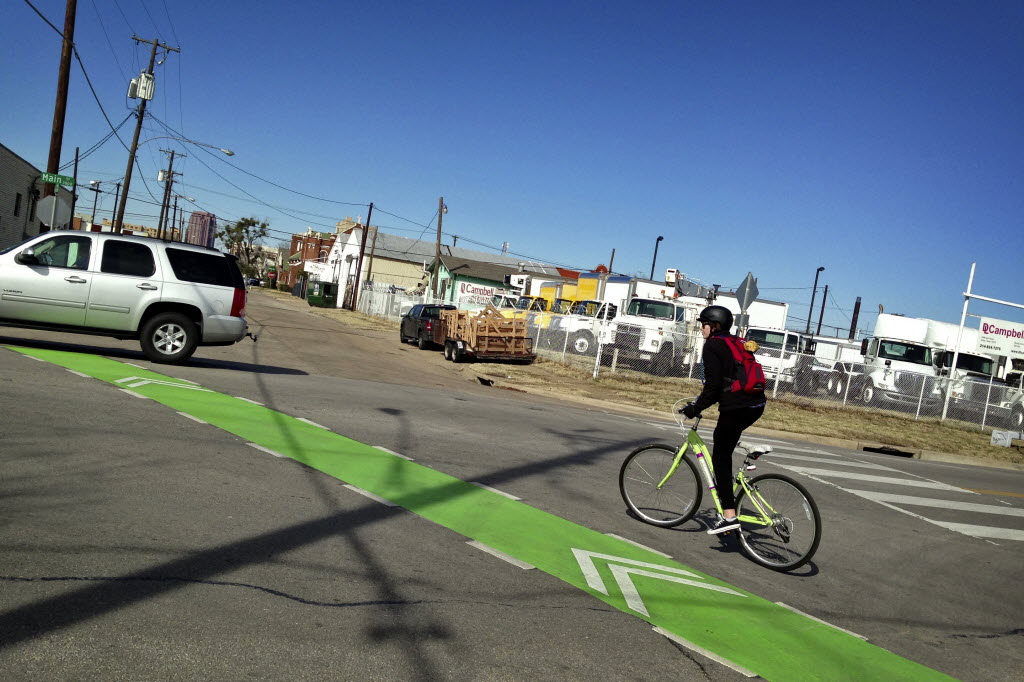
Workshop participants Tony Morris and Candace Thompson mark on a map where they live and where they work during a community development workshop Tuesday in Oak Cliff. (Elizabeth Findell/Dallas Morning News)
South Dallas resident Tony Morris and his 7-year-old son Emerson both had opinions to contribute on what their neighborhood needs during a development workshop at the South Oak Cliff High School Tuesday.
Emerson supported houses — all houses — while Morris bemoaned a lack of jobs near communities where many workers live.
“There are no corporate jobs south, so what is Dallas going to do about that?” he asked event facilitators. “At the end of the day, if I can stay in my neighborhood, I’ll take care of it. I have to drive hours away.”
Other south-side residents pointed to grocery options, services for seniors and sidewalks and walkable areas as things missing from Oak Cliff area neighborhoods.
The community workshop was a step in the city’s Inspire Dallas Housing Plus effort, which seeks to broaden city low-income affordable housing efforts to consider whole neighborhoods and what they need for families to be successful there. It was the first of four workshops to ask residents what their lifestyle priorities are, what things their neighborhoods lack and what type of housing they would like to see built in the future.
Other workshops will be held today at the San Jacinto Elementary School on Hume Drive, Thursday at the Walnut Hills Recreation Center on Midway Road and Saturday at City Hall. The two during the week are from 5:30 to 7:30 p.m. and one at City Hall Saturday is from 9 a.m. to noon.
City-sponsored housing makes up 2 percent of all housing, and other publicly supported units make up 4 percent.
“We know that whatever we do, our efforts are very small — they’re a drop in the bucket,” said Theresa O’Donnell, the city’s chief planning officer, during a committee hearing on housing Monday. “If we can influence the market with a grocery store, if we can influence the market with a healthcare provider, with transportation — what can we do to influence the market?”
The roughly two dozen residents who turned out to Tuesday’s workshop first heard data the city has compiled indicating that job growth in Dallas is outpacing residential building. The median income has dropped from $52,615 in 2000 to $41,960 this year — possibly because of the city’s growth in young people. Dallas is younger than Texas and the United States by increasing margins.
As the city’s 18 to 33-year old “Millenial” population has grown, so has its Hispanic population. Forty six percent of the city’s Millenials are Hispanic, compared to 26 percent white and 22 percent African American. Unlike many cities, many low-income families own homes, while many high-income households choose to rent.
Most of the new housing units being built in the city are apartments or other multifamily units. The workshop asked participants what kind of housing would be best to develop in vacant lots around the city, which most of the options getting some support.
Morris and several other participants said they would like to see neighborhoods develop nicer areas without driving out existing residents.
“To me the perfect mix of income is like Colorado, Bishop Arts,” Morris said. “It’s one of the very few diverse income areas where you have the poorest of the poor and you have nicer homes… That should be the model.”
Peer Frank Chacko, assistant director of city sustainable development and construction, said he hopes to have a draft plan in place by the end of the year outlining regional neighborhood priorities and what the city and the businesses and nonprofit organizations it works with can do to assist with them.
Judy Brooks, a participant in Tuesday’s workshop, said she was interested to see how Inspire Dallas could affect her Kiest Park neighborhood and was concerned about infrastructure as younger families move south.
“I think they’re baby steps right now,” she said of the workshop. “I hope it’s not all talk and no action.”









